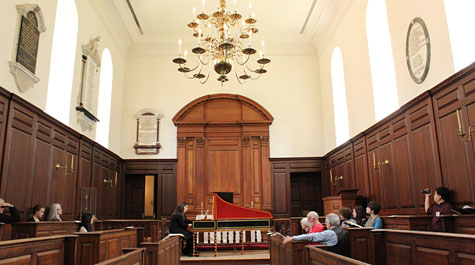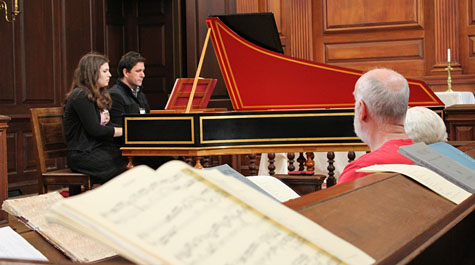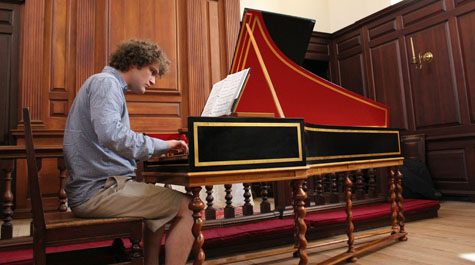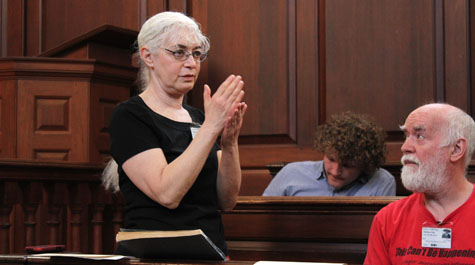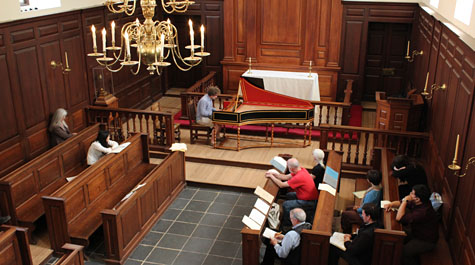Making music together: W&M, Temple students host harpsichord master class
The sounds of the 18th century filled the Wren Chapel last week as a group of graduate students from Temple University’s Boyer College of Music and Dance joined with William & Mary students for a harpsichord master class.
Thomas Marshall, instructor of organ, piano and harpsichord at William & Mary, and Joyce Lindorff, professor of keyboard at Temple, led the April 28 class, which included performances by students from both universities on a reproduction 17th-century French harpsichord as well as the restored, circa 1740 organ that resides in the balcony of the chapel.
{{youtube:medium:left|mAdJbqst8xY, Harpsichord in the chapel}}
"Having the chance to touch and play on antique or reproduction keyboard instruments is almost as close to history as one can get,” said Marshall.
“When linked closely together with historical research in understanding proper performance practice, it is possible to jump across centuries to feel and hear something of the essence of Bach, Handel and Couperin. Williamsburg is fortunate to have a good study backdrop to make these experiences real for our students. I was proud to see our Temple University student guests become more inspired with each experience throughout the week.”
The class was part of a week-long visit to Williamsburg by the Temple students that included stops not only at William & Mary but Colonial Williamsburg’s museums and John D. Rockefeller, Jr. Library.
“My students are experiencing Williamsburg for the first time,” said Lindorff, who also gave a harpsichord recital on Thursday at Bruton Parish Church. “You all are so lucky. You know that right? Because you’re living in this 18th century world that we harpsichordists can learn so much from. We’re very thrilled to visit with you and have the chance to collaborate.”
William & Mary students Susannah Philbrick ’17, Bronte de Cardenas ’16, Emerson Sieverts ’15 and Monica Huang ’17 played a variety of pieces by Bach and Mozart, beginning with “Praeludium in C” and “Praeludium in F” – two of the primer pieces that Bach wrote for his children and students to learn how to play the harpsichord, said Marshall.
As Philbrick and de Cardenas prepared to play “Duet Sonata in C Major” by Mozart, Marshall paused to point out how the pair’s hands would become entwined during the performance, much as Mozart and his sister are portrayed in a painting by Johann Nepomuk della Croce.
“So the next time you see that painting and you’re reading up on Mozart, remember, we actually saw it done here,” Marshall said.
Temple graduate students Irene Moretto and Silvanio Reis also performed a Mozart duet, in addition to solo pieces of Bach and Couperin.
Between performances, Marshall and Lindorff discussed some of the history and intricacies of harpsichords, which “never went out of style,” said Marshall, but were modified as musical styles and tastes changed, often having keys added to them.
Although many modern keyboardists know how to play the harpsichord, fewer know how to tune it – a significant issue for an instrument that was beginning to go out of tune just 20 minutes into the master class
At Temple, in addition to performance, Lindorff teaches students the basics of what to do if they break a string or a quill, a small part of the harpsichord used to pluck strings.
Marshall said he never leaves home without his repair bag, “because if I do, I won’t have the right tools.”
At one concert, Marshall recalled, he had to replace a quill but did not have one on him. Improvising, he used a fingernail.
“I clipped the nail off, and it was just perfect,” Marshall said, to laughs from the students.
“I’m sorry to tell you that for the bass strings, you’d have to use a toenail,” Lindorff quipped.
Although harpsichord performances were the centerpiece of the class, the Wren Chapel organ – on loan to the university from the Colonial Williamsburg Foundation – was also utilized by Temple University student Qiao Chu, who put it through its paces with the Chromatic Fantasy of Jan Pieterszoon Sweelinck. From the balcony, Huang also played a duet with Sieverts on the harpsichord, giving the piece “a stereo effect,” said Marshall.
Although Temple’s students were playing the historical instruments they came across during their visit somewhat “cold” – without practice – Lindorff said that the experience wasn’t “as hard as it was inspiring – like meeting a new person with unique and interesting qualities.”
Marshall pointed out that although they would never be able to meet Thomas Jefferson or talk to him, “I can certainly hear the sounds that he heard, and I believe that musical instruments are a real, ideal connection to this history that we can read about but don’t know.”
Lindorff noted that this is a perfect time for students to begin exploring the harpsichord since research on the instrument has greatly progressed since the early 20th century.
“Now we have so much more, and the instruments are built so beautifully,” she said. “I think we’re at a point now where we’re willing to experiment a little bit.”
Both Lindorff and Marshall encouraged the students to improvise with the harpsichord as they continue their studies.
“The basic word I would say to you would be ‘freedom,’ so make the musical choices that you feel best express the music,” Lindorff said. Skip to main content
Skip to main content

